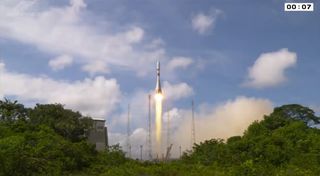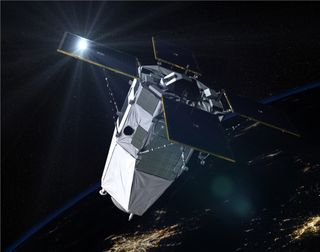Arianespace launches French military spy satellite on Soyuz rocket to cap 2020
The French military's CSO-2 is now in orbit.
Arianespace launched a new reconnaissance satellite for the French military into orbit Tuesday (Dec. 29), marking the European launch provider's final mission of 2020.
A Russian-built Soyuz rocket launched the satellite, called Optical Space Component 2 (or Composante Spatiale Optique 2, CSO-2, in French) from the Guiana Space Center in Kourou, French Guiana in South America. Liftoff occurred at 11:42 a.m. EST (1642 GMT) after a one-day delay due to bad weather.
CSO-2 is a next-generation Earth imaging satellite designed to help replace France's aging Helios 1 and 2 systems.
Related: The 10 biggest spaceflight stories of 2020

"CSO-2 is the second in a constellation of three identical military observation satellites that will operate in different polar orbits to accomplish two missions: reconnaissance for CSO-1 and CSO-3, and identification for CSO-2, which will be joining CSO-1 launched in December 2018," officials with the French space agency CNES, which is overseeing the mission, said in a statement.
Built by Airbus, the 7,852-lb. (3,562 kilograms) CSO-2 will orbit the Earth at a distance of about 300 miles (480 kilometers), lower than its predecessor CSO-1, which had a 500-mile (800 km) orbit. The satellite was successfully deployed about an hour after liftoff.

"It will acquire very-high-resolution day/night, clear-weather imagery in the visible and infrared in a range of viewing modes to serve a broad spectrum of operational requirements," CNES officials wrote in the statement.
Get the Space.com Newsletter
Breaking space news, the latest updates on rocket launches, skywatching events and more!
According to Spaceflight Now, the CSO satellites are expected to have a resolution of about 14 inches (35 centimeters) from that 500-mile orbit. CSO-2 is designed to last at least 10 years in orbit, CNES officials have said.
The French government is reportedly spending $1.5 billion on the new CSO surveillance satellite program, a cost that includes the satellites and ground-based systems, Spaceflight Now reported.
The successful launch of CSO-2 marked the 10th mission of 2020 by Arianespace and its fifth Soyuz flight this year. But even as the company winds down for the year, it has a series of Ariane 5, Vega and Soyuz flights for 2021, including the much-anticipated launch of NASA's James Webb Space Telescope on Oct. 31.
"2021 is set to be intense for Arianespace," Arianespace CEO Stéphane Israël said after launch. "So, 2021 is set to be a very busy indeed and that is why, here, we'll take a bit of a rest now at this end of the year."
Email Tariq Malik at tmalik@space.com or follow him @tariqjmalik. Follow us @Spacedotcom, Facebook and Instagram.
Join our Space Forums to keep talking space on the latest missions, night sky and more! And if you have a news tip, correction or comment, let us know at: community@space.com.

Tariq is the Editor-in-Chief of Space.com and joined the team in 2001, first as an intern and staff writer, and later as an editor. He covers human spaceflight, exploration and space science, as well as skywatching and entertainment. He became Space.com's Managing Editor in 2009 and Editor-in-Chief in 2019. Before joining Space.com, Tariq was a staff reporter for The Los Angeles Times covering education and city beats in La Habra, Fullerton and Huntington Beach. In October 2022, Tariq received the Harry Kolcum Award for excellence in space reporting from the National Space Club Florida Committee. He is also an Eagle Scout (yes, he has the Space Exploration merit badge) and went to Space Camp four times as a kid and a fifth time as an adult. He has journalism degrees from the University of Southern California and New York University. You can find Tariq at Space.com and as the co-host to the This Week In Space podcast with space historian Rod Pyle on the TWiT network. To see his latest project, you can follow Tariq on Twitter @tariqjmalik.










